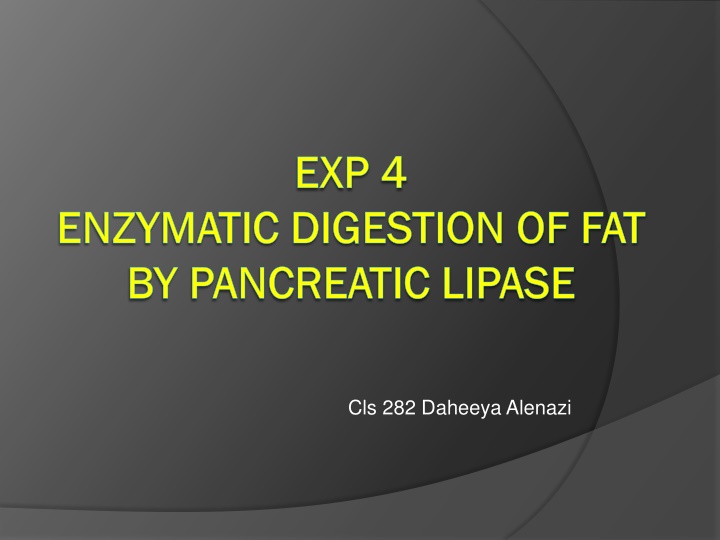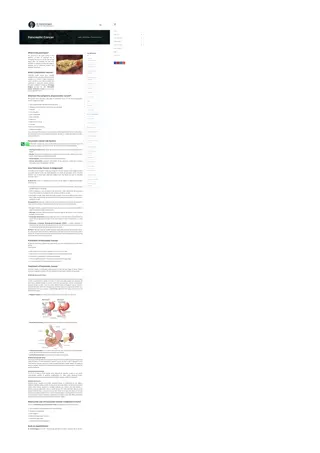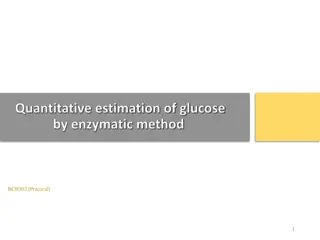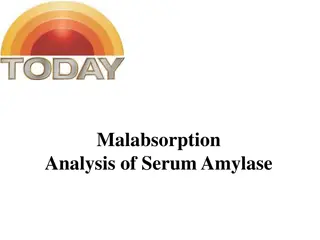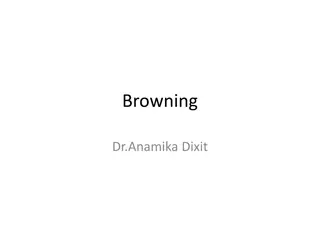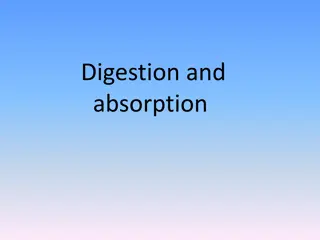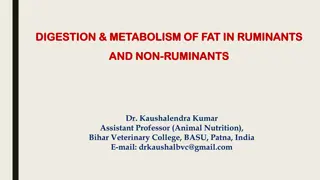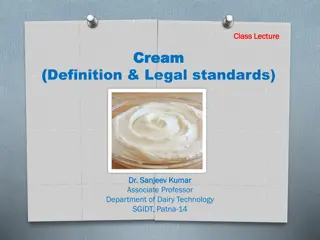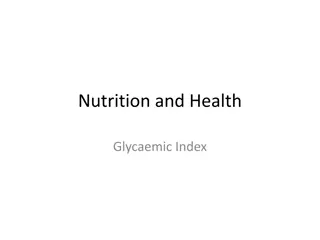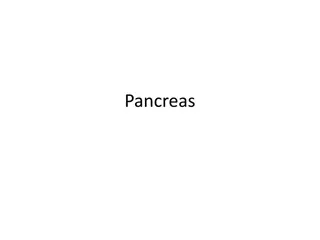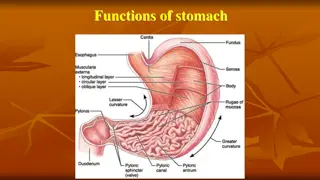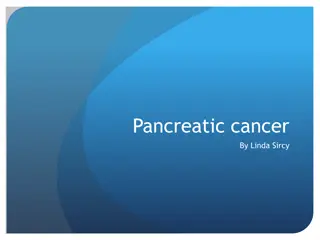Enzymatic Digestion of Fat by Pancreatic Lipase
The experiment focuses on studying the enzymatic digestion of fat by pancreatic lipase. It covers the structure of triglycerides, the role of lipase enzyme in hydrolyzing triglycerides to release fatty acids, and the general hydrolysis process. The aim is to investigate the effects of lipase enzyme and physical changes on enzyme function. The procedure involves using milk, litmus solution, pancreatic enzymes, and calcium hydroxide to observe the hydrolysis process in a laboratory setup.
Download Presentation

Please find below an Image/Link to download the presentation.
The content on the website is provided AS IS for your information and personal use only. It may not be sold, licensed, or shared on other websites without obtaining consent from the author.If you encounter any issues during the download, it is possible that the publisher has removed the file from their server.
You are allowed to download the files provided on this website for personal or commercial use, subject to the condition that they are used lawfully. All files are the property of their respective owners.
The content on the website is provided AS IS for your information and personal use only. It may not be sold, licensed, or shared on other websites without obtaining consent from the author.
E N D
Presentation Transcript
EXP EXP 4 4 ENZYMATIC DIGESTION OF FAT ENZYMATIC DIGESTION OF FAT BY PANCREATIC LIPASE BY PANCREATIC LIPASE Cls 282 Daheeya Alenazi
Introduction Introduction Fats (lipid) : consist of a wide group of compounds that are generally soluble in organic solvents and largely insoluble in water. A triglyceride consists of a glycerol and three fatty acids. It is the major type of lipid used for energy storage Fatty Acids: The lipid building blocks. http://upload.wikimedia.org/wikipedia/commons/thumb/5/51/Butanoic_acid.png.svg/220px-Butanoic_acid.png.svg.png
Triglycerides structure Triglycerides structure
Lipase Enzyme Lipase Enzyme Lipases: are enzymes which hydrolyse the triglycerides, releasing fatty acids. Sources: Pancreatic tissue , Germinating oil seeds http://www.google.co.uk/images?q=tbn:8WTr2GsV8T-BlM::www.seatons-uk.co.uk/images/layout/seatons/industrial/triglyceride.gift=1h=88w=108usg=__kJK0V8W9QzbPToeTfZLvmW8HNaA= +3H O lipase glycerol + 3 F.A Substrate : any oil ( has to be emulsified) can be used or milk also can be used
Aim of the test Aim of the test 1. Study the effect of lipase enzyme. 2. Study the effect of physical changes on the enzyme function.
General hydrolysis of fat General hydrolysis of fat The hydrolysis process can give all three fatty acids or it can yield one or two F.AS with diglycerides and monoglycerides... FA1 FA2 FA3 FA2 Lipase + Lipase FA 2 FA1 2-Monoacylglycerol FA3 FA2 Triacylglycerol Diacylglycerol
Materials Materials 1. Fresh whole milk 2. Litmus solution ( or litmus paper) as an indicator. 3. Pancreatin solution (boiled, unboiled). 4. 1% Calcium hydroxide solution (accelerator) http://t3.gstatic.com/images?q=tbn:ANd9GcS3xKCVP-KZjmwF02fi6sbuLMiRzVgszKYXihZE6Dfio55pjuu0JT9MzA http://t0.gstatic.com/images?q=tbn:ANd9GcQX-UdSUU5Y-8bdXoiEBSEpqtvBCRaYmkvBJrjem020EsdM0rB6ovJJTQ
Procedure Procedure 1. In test tube (A), add 4ml of milk. 2. Add 10 drops of litmus sol. 3. Add 3 drops of Calcium hydroxide Ca(OH) 4. Transfer Half of tube (A) to another tube (B). 5. Add 1ml of (un-boiled) pancreatin to tube (A). 6. Add 1m of (boiled) pancreatin to tube (B). 7. Incubate both tubes in water bath (45c) or hot plate for 4-6 hrs. http://t0.gstatic.com/images?q=tbn:ANd9GcS3JglK-JYERHSWsigv4fMxykvxmdI9_MUt9qKPty43EcSpD8nfPaQCpRc
Results Results 1. Accumulation of free fatty acids will gradually reduce the PH of the fat mixture as can be noted in the presence of an indicator. 2. Pink colour with indicator as positive result: Because of F.A and salts react with indictor litmus sol. 1. Odour 2. Precipitate due to the presence of protein 3. Tube B not change because of using boiled pancreatin Deactivation of enzyme.
